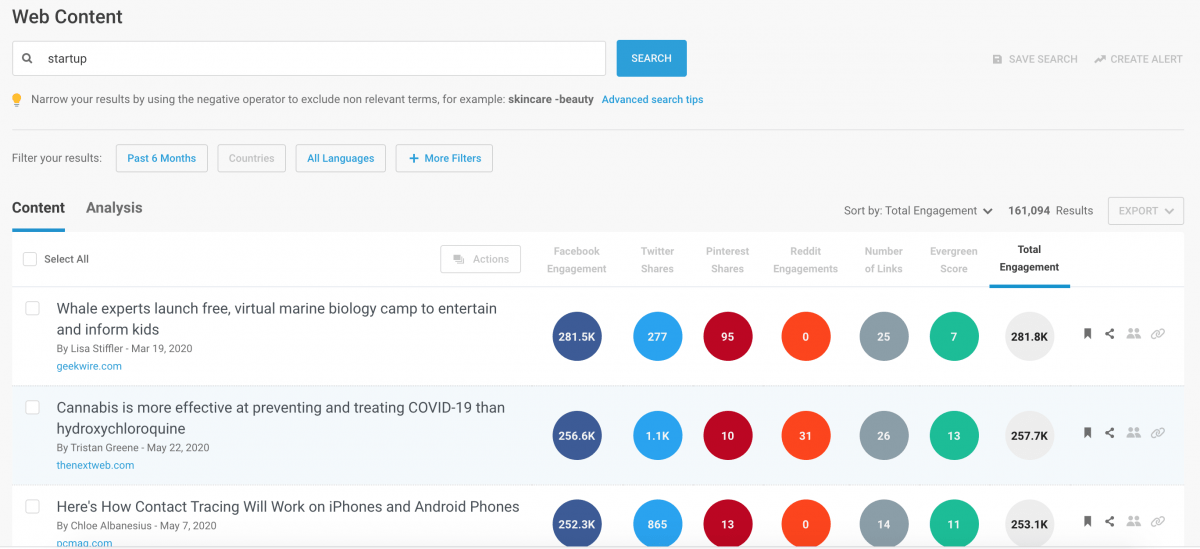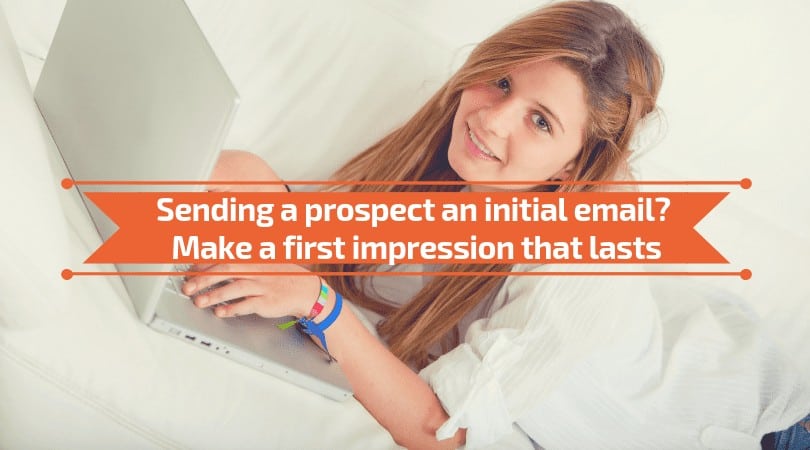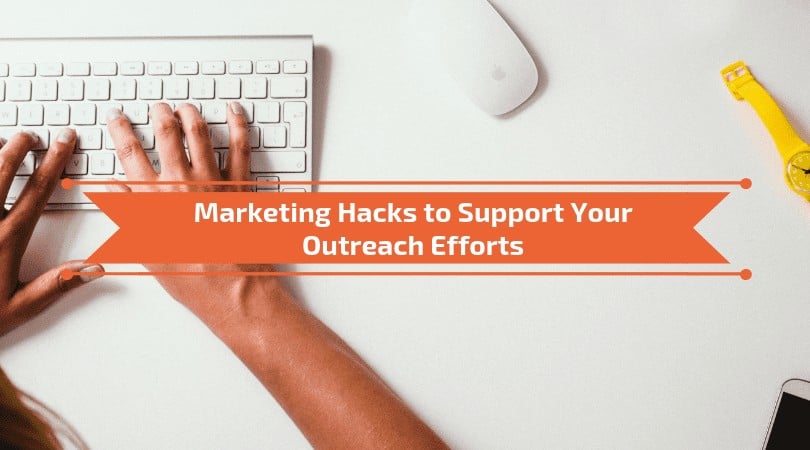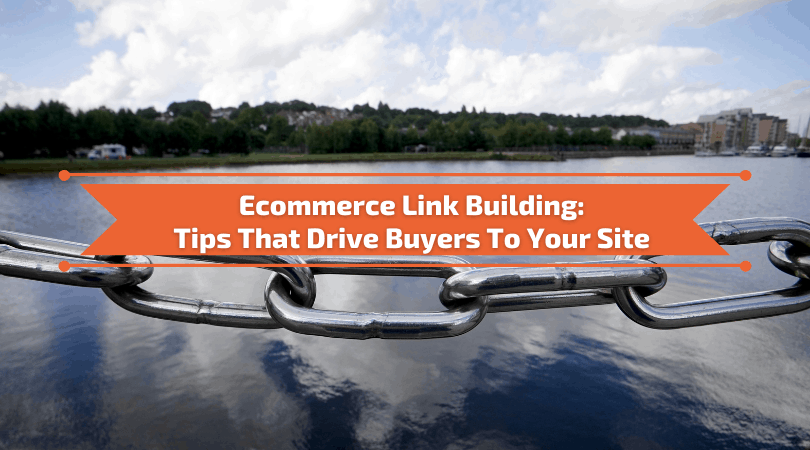In the modern digital age of saturated marketing messages, getting press communication right is more important than ever.
Personalisation, getting right to the point and homing in on your targets’ interests is key to ensuring your editorial gets the coverage it deserves.
Here we help you do exactly that by covering every stage of the outreach process, from prospecting to angle ideation, pitching and writing your release.
1. Prospecting
The first rule of your PR strategy should be to never pay for links. Buying links will hurt you in the long run; Google was smart enough to identify and penalise this sort of activity in 2012, so the chances of you getting away with it (let alone benefiting from it), in 2021 are extremely limited.
With that in mind, prospecting becomes even more essential. You’re not dealing with link sellers anymore; you’re speaking to bloggers and journalists at authoritative websites.
Every step of the prospecting process must be precise to achieve the best results from your PR strategy.
To make your life easier, we’ve put together the following list of rules for prospecting:
01. Time
Send out emails between 8 AM and 12 PM, before mailboxes become too full.
02. Research
Select your press lists carefully, ensuring that you only contact journalists who are directly relevant to your release.
Make sure to research which publication(s) they write for and what they’ve written about previously. If your content is irrelevant, they will block you or ask to be removed.
03. Tools
Create press lists with a media relations tool such as Response Source, an essential source of media contacts and coverage opportunities.
04. Lists
Separate your lists into smaller ones for more niche subjects, and keep your larger lists for outreach to more wide-reaching topics, such as those suitable for national press.
2. Email Process

In addition to implementing an effective prospecting strategy, it’s also crucial to establish a consistent email process. Utilize an email marketing platform, such as HubSpot or YesWare, to send emails, as this will enable you to manage larger lists and easily follow up with emails.
You’ll also gain access to reports detailing open rates, enabling you to identify what works and what doesn’t.
Once you’ve chosen an email marketing platform, follow these steps to ensure a consistent, high-quality approach:
01. Format
First, upload your press list in the correct format for your chosen platform.
02. Personalise
Then, personalise your email:
- If it’s a small list of around ten people, tailor the message to each contact, referencing their previous work and explaining why your content is relevant to their portfolio/ specialism/interests.
- A large contact list of a few hundred or more will necessitate a blanket message. Still, there is usually a personalisation feature that will automatically insert each contact’s name at the start.
03. Test
Always send a test email to yourself first to review it.
3. Angle/Idea Generation
If your audience doesn’t care about what you have to say, you need to find out what they do care about.
- What do they love?
- What do they hate?
And, most importantly, how can you relate this to your brand? Once you fully understand what you’re trying to achieve from the campaign, you can concentrate on idea generation.
While creativity isn’t a scientific process (and shouldn’t be treated as one), there are a few tried-and-trusted tactics to help you maximise your chances of choosing an idea and angle strong enough to cut through the noise.
However, effective prospecting and eye-catching emails will count for little without a great idea or angle.
Ideation can be a real challenge if you don’t approach it in the right way; one common pitfall is to brainstorm dozens of products and tactics (“we can make a video”, or “we’ll commission a survey”) rather than thinking about the campaign as a whole.
Try to move from smaller-scale to larger ideas by working from the inside out, starting with your brand and identifying connections to broader themes, as demonstrated in the mind map below.
One technique involves scouring the wealth of content sources out there to form original and effective creative ideas.
Consider using the following sources to get some inspiration:
- Ahrefs Content Explorer
- BuzzSumo
These tools should be used to identify the most popular topics and angles among the press. You can use this information to inform your own angles for press releases and editorial articles.

Still struggling to develop the idea that’s strong enough to generate the coverage your brand needs?
01. Sign up to emails such as Journo Requests and social media notifications such as the #PRRequest hashtag to determine what content journalists are already looking for.
02. Keep a calendar of forwarding features related to areas of your business. You can look for forwarding feature requests with a tool such as Response Source. Just remember to include all key annual occasions such as bank holidays, half terms, etc.
To run this calendar, you will need to coordinate with your:
- Marketing plan for each quarter/year
- Brand guidelines
- Current PR activity levels and contacts to avoid/ blacklist
At the end of this process, you should find yourself left with two or more well-thought-through campaign themes, plus supplementary ideas like blog titles and topics for infographics.
If you’re struggling to choose which idea to proceed with, consider putting it to a vote, ideally involving people from a wide range of roles, and with different experience levels.
4. Forming a Pitch
So you’ve settled on a killer idea. Now you need to ensure your campaign gets the attention it deserves, which means crafting an attention-grabbing pitch that your contacts won’t be able to ignore.
4.1 Crafting Your Pitch Email

While you should strive to keep the ideation phase as organic as possible, pitching is much more of a numbers game. Accept that a high percentage of your emails are likely to remain unread and that your idea won’t appeal to everyone you contact.
This doesn’t automatically mean it’s a bad idea; it just doesn’t align with their content calendar. However, you can take steps to give your idea the best chance of being noticed, and it all starts with the pitch email.
4.2 The tested formula of a successful pitch
There’s a formula behind a successful pitch – every email should tick the following boxes:
- Explain why the campaign is relevant to that recipient.
- Include a headline that relates to subjects they have written about previously.
- Don’t be unnecessarily formal. Instead, strike a conversational tone to form a connection with the recipient. It can also help to follow your contacts on social media to get a sense of what they’re discussing, and even strike up a conversation.
- Fit your pitch into a clearly-defined category/sector (e.g. travel, health and fitness, lifestyle, finance, news, food & drink). For guidance, look at the publications you’re reaching out to and check which section your pitch fits into best, then see who edits that section and what type of articles they’ve written before. For example, a pitch discussing the impact of outdoor nurseries on children’s health would be relevant to someone who has written about childhood obesity in the past and fit into the education sector.
- Don’t end your email with ‘regards’ – it has been proven to result in decreased response rates.
- Don’t spend too much time talking about yourself or your product. Please talk about the story and why it’s interesting to the reader, always beginning with your most interesting stats/research.
- Avoid sending duplicate content as your main feature. The exception to this rule is a press release, which can be sent en masse to quickly glean as much interest as possible from your prospect list.
- Use press releases as a tool to promote the campaign. Keep them to a word count of 300-500 words.
- If you’re pitching a piece of editorial content, remember only to send out a summary; reply to requests for the full piece with unique content.
4.3 Writing a Press Release
Press releases are an excellent way to disseminate your campaign to a broad audience of contacts. Journalists might take the bait and use the information as the basis for an article or request further details.
Either way, your press releases must be clear and well-written. View the press release as an add-on to your pitch; it should be concise and compelling enough that the recipient wants to read on while containing the key pieces of information that you most want to communicate to your contacts.
Struggling to craft the perfect press release?
Not sure what to include?
Fortunately, we’ve put together two examples, inspired by successful real-world campaigns. Feel free to use these templates for inspiration:
4.3.1 Example 1:
Subject: Pain-Free Dental Practices? Nervous Patients Fear No More
Content:
[Greeting]
Hope you’re well?
I’m getting in touch on behalf of my client, a private dental practice based in Scotland.
Following a study this year which found that almost half of UK adults have a phobia of the dentist, they have produced a press release based on revolutionary pain-free dental practices.
These practices operate more like luxury spas, with an emphasis on relaxation and easing any preconceived fears by totally alleviating discomfort and creating positive associations. This includes the avoidance of drills, painless injections, providing back massages and hand wax treatments. There are even DVD glasses and iPods to watch films or listen to music during their treatment!
Do let me know if this would be of interest for your readers and I can send across the editorial for you to have a look at?
Thanks,
Joe
4.3.2 Example 2:
Subject: Forget Moaning About the Cold: What Do Brits Love About Winter?
Content:
[Greeting],
I hope you’re well today and don’t mind me getting in touch.
We have done a quick focus group to find out what people think about the winter months, and what they look forward to once summer is just a distant memory.
Read more below and please let me know if you would like specific quotes or comments.
Thanks,
Joe
Brits spend a lot of their time moaning about the weather; but what about all the things we look forward to in winter?
How do we make the most of the colder months?
It was reported this year that Brits spend 10 months of their lives moaning about the weather. Wetter days are to blame for frustration and lethargy when the sun goes away, but what are all the little things we enjoy about the winter season?
Key Stats From Season Poll
- 18/34 responses were food-related
- 15/34 of responses were winter clothing-related
- 15/34 responses were related to staying indoors
- 9/34 responses were related to being outside
- 13/34 responses were Christmas-related
More info for context: https://www.metro.news/we-spend-10-months-of-our-lives-moaning-about-the-weather/761697/
4.4 Frequency of Pitch Emails and Follow-Ups
As with crafting a pitch and writing a press release, there’s a formula for success when it comes to emailing your contacts. Too much and you’ll put them off; not often enough and you risk being overlooked or forgotten.
Stick to the following format to maximise the chances of your emails being picked up:
Perform your first follow-up three to four days after the first round of outreach and slightly edit the greeting message. Perform your second follow-up 7-10 working days after the first, targeting only non-respondents.
If you have sent your contact a piece of editorial on request but are waiting for a response as to whether the article is live, check their site to see if it has been published.
Otherwise, follow up again 7-10 days later to see if it will be used. When journalists respond, please note in Response Source/HubSpot next to their contact details.
5. Quality Checking
Journalists receive dozens (if not hundreds) of emails every day from brands and PR agencies desperate for their creative ideas to be heard. With so much competition, you must make a great first impression.
Remember that journalists are professional writers. They care about words and grammar. If your email is riddled with typos, inaccurate data or broken links, you can guarantee they won’t take the time to respond.
In short, quality checking is a vital step in the outreach process. Always carry out the following steps before emailing your contacts:
- Always double-check all spelling, links and data.
- Use a press release template for consistency.
6. Obtaining Data
High-quality data can be the difference between your press release succeeding or failing. Whether you’ve commissioned an independent survey, reached out to influencers through social, or repurposed third-party research, good data is worth its weight in gold.
Not every PR campaign has the resource or budget available to produce a bespoke survey capable of attracting sufficient responses.
In this instance, there are plenty of resources offering data that are ripe for repurposing.
01. Office for National Statistics
02. Open Office
03. Gov.UK
04. Reddit
05. Facebook
Groups such as UK Blogger Opportunities and Official UK Bloggers can conduct mini-surveys, obtaining quotes from influencers and crediting them.
Non-professional Facebook groups that fit into the different sectors are also worth joining, such as:
- Home and Garden
- Travel Addiction
- Health and Fitness
06. Freedom of Information
Freedom of information requests enable us to obtain recorded information from any public sector company.
You can find all the information on how to request the information you are looking for.
- There are various organisations allocated to different types of information request.
- Your request could be refused if the information is too sensitive, so decide carefully.
For example, Manchester City Council could be consulted on how the May 2017 terror attacks affected tourism in the city.
07. Bloggers

Reaching out to bloggers, influencers and experts to comment on a given topic is a great way to add some colour and context to your PR campaign.
However, if you’re going to make use of this valuable tactic, you should consider the following best practice points:
- Always be honest and transparent; tell the person you’re contacting what you’ll do with the info they provide and what they will get in return.
- Make sure you accurately print participants’ names / sites / blogs / titles.
- Some responders may wish to remain anonymous (especially on Reddit), so always ask whether you can use their name, and never publish it without permission.
7. Testing Your Idea
Not only have you arrived at a great idea, but you’ve also got the data to support it. Surely that means your PR campaign is destined for success?
Perhaps, but we don’t like to leave these things to chance! Before you contact journalists, take the time to find out what “real people” think about your campaign.
It’ll help you iron out any creases that you might have missed (which can be all too easy when you’re close to a project) and might provide a few useful pointers to hone your pitch.
Here’s our process for testing an idea:
01. Post the content onto imgur.com – you don’t need a username, but it’s probably worth getting one, so you can use it again in future. Your content should look like this.
02. You need to get some people to see it, and for this, we will use Reddit.com. Search for your content title on Reddit and find a relevant subreddit. For this example, we found: https://www.reddit.com/r/surfing/
03. Post the Imgur link on Reddit (unlike brand URLs, Reddit loves Imgur). It should look like this
N.B. Before you get carried away, set up a Reddit account and engage in some general interaction, building credibility by upvoting or sharing content that is already popular. The reason is that most subreddits don’t let new accounts submit content.
Next, post your content with a relevant title. It should look like something like this.
Please review the comments and make adjustments to the content to increase its appeal to journalists. It is invaluable to receive feedback from posters on niche threads who possess deep knowledge or a strong interest in the topic and represent the demographic you aim to target.
8. Tracking Performance
Finally, you’ve reached the point where you have a solid idea, supported by data and backed up by user feedback on Reddit. But there are still plenty of learnings waiting for you – not least how journalists respond to your messages.
Using a software program like Yesware will enable you to measure open and click-through rates, as well as understand how journalists respond to your content.
This will allow you to make positive changes to the way you outreach in the future. You can only improve this vital part of the PR process by reviewing what you’ve done in the past based on hard data.
9. Conclusion
And there you have it: a full process for press outreach that gives you ample opportunity to hone your idea, craft a compelling email to journalists, and make improvements based on what you know works well. (and what doesn’t).
This may seem like a lot of boxes to tick, but if you’re serious about PR, you’ll appreciate that it’s worth the effort.

Whether your end goal is to secure links to key pages or gain coverage to grow brand awareness, an effective PR strategy is invaluable, so why wouldn’t you put in the necessary work to give it the best chance of succeeding?
Of course, many in-house marketers lack the resources to deliver a quality PR campaign.
Fortunately, we’re here to help!

![How to do Media Outreach in 2020 [Complete Guide]](https://competico.com/wp-content/uploads/2020/07/How-to-do-Media-Outreach-in-2020-Complete-Guide.png)
![Read more about the article How to create an expert roundup [Complete Guide]](https://competico.com/wp-content/uploads/2018/08/global-expert-img3_0-300x208.jpg)


Media Outreach is the most important aspect of digital marketing. So thanks for sharing worthwhile knowledge.
Media outreaching is one of the best methods for digital marketing. And it can be more beneficial for our websites. In this blog completely understood how to use media outreaching methods for digital marketing. And It’s is providing a lot of help to newcomers in this field.
“Social media outreach” is one of the best ways to form new relationships, increase engagement & get more eyes on your content. Executing a successful outreach campaign can be difficult, tedious and even frustrating sometimes. But the results you can get from it make your efforts more than worth it.
Media outreach is one of the most important things to make your business grow, thanks for this very informative blog, we can apply some of these tips on our campaign.